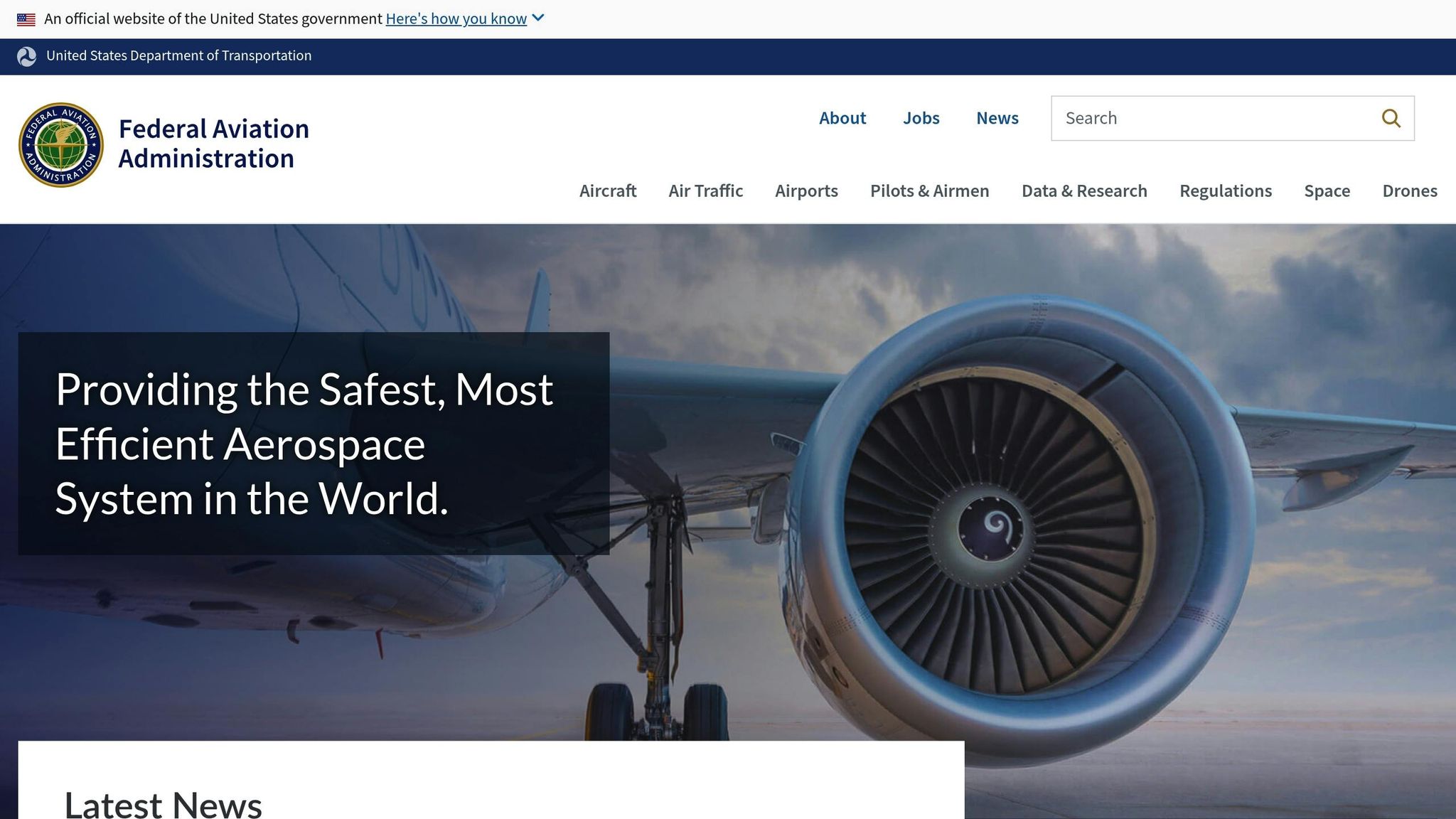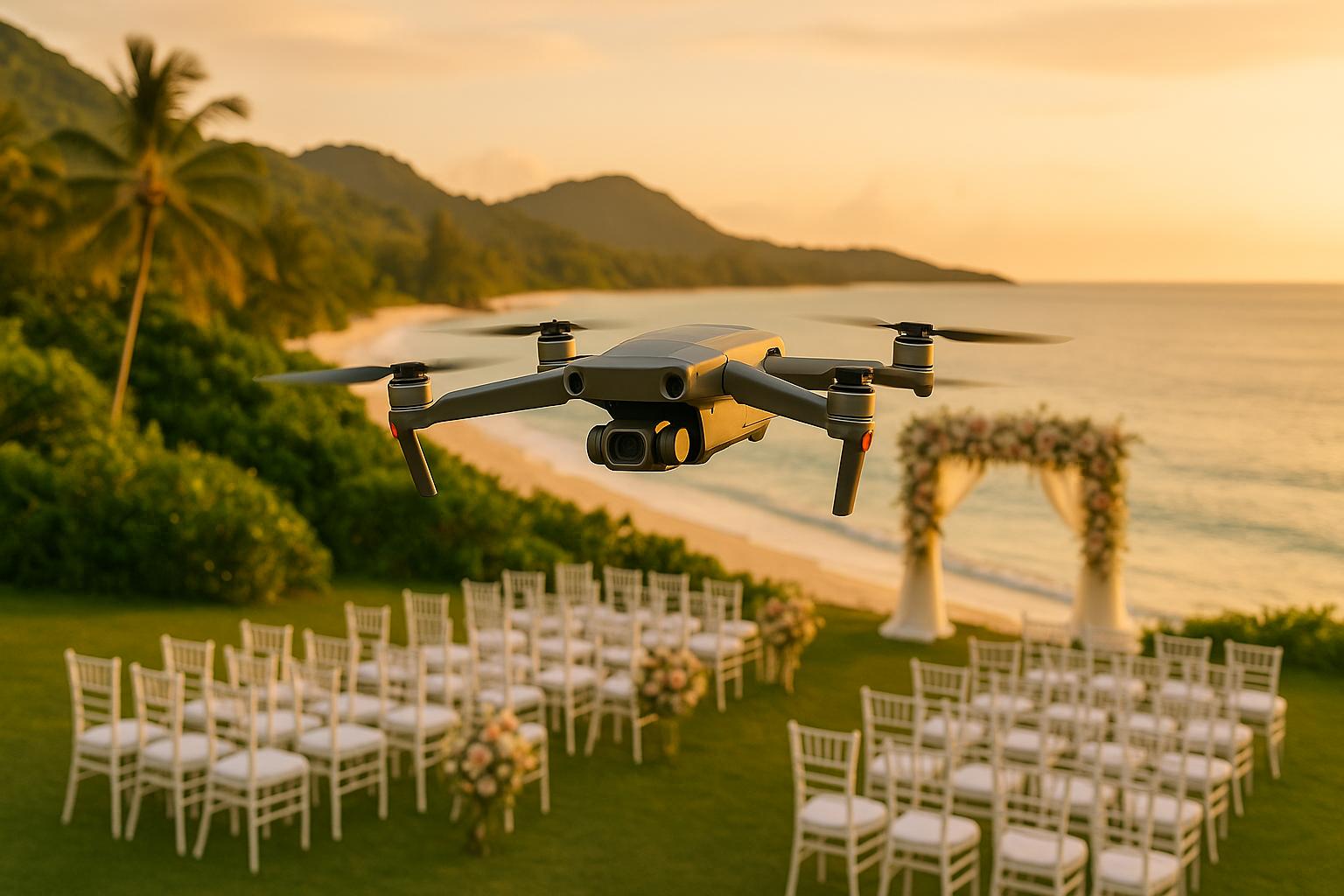Want to capture stunning drone footage for destination weddings? Here's a quick guide to help you get it right:
- Scout the Venue: Check for hazards (trees, power lines) and plan creative aerial shots using satellite imagery.
- Follow Drone Laws: Research local regulations, secure permits, and confirm venue policies.
- Plan Your Shots: Create a detailed shot list for key moments like vows, entrances, and dances.
- Practice Drone Moves: Master basic techniques like orbits, reveals, and tracking shots.
- Time for Best Light: Shoot during golden hours (sunrise/sunset) for soft, flattering light.
- Coordinate with Vendors: Work with planners and photographers to avoid disruptions.
- Pack Backup Gear: Bring extra batteries, propellers, and protective cases for emergencies.
- Choose the Right Drone: Match the drone to the venue's size and layout.
- Prioritize Safety: Minimize noise, avoid strong winds, and keep a safe distance from guests.
- Edit Like a Pro: Use color correction, stabilization, and smooth transitions for polished results.
Pro Tip: Always prioritize safety and respect local customs. By combining preparation, technical skill, and collaboration, you can create unforgettable wedding footage.
12 TIPS ON USING DRONES AT WEDDINGS
1. Check the Location First
Before capturing aerial footage, take a close look at the venue. Ensuring safety while planning creative shots is key to achieving stunning results.
Safety Assessment
Be on the lookout for potential hazards overhead. Common risks include:
- Power lines and utility poles
- Tall trees or overhanging branches
- Building structures or temporary setups
- Cell towers or radio antennas
- Event features like tents, arches, or lighting installations
Once you've addressed safety concerns, you can shift your focus to finding the best spots for breathtaking shots.
Strategic Vantage Points
Look for areas that naturally provide impressive aerial views. For example:
- A beachfront ceremony with a glowing sunset backdrop
- Venues with striking architectural elements
- Locations featuring private plunge pools or other standout features
Pre-Flight Planning
Use satellite imagery to double-check your observations and uncover any hidden obstacles that might not be obvious during an on-site inspection.
Weather and Wind Conditions
Always check the wind and weather forecasts before taking off to ensure a smooth and safe flight.
2. Know Drone Laws and Rules
Drone rules can differ widely depending on where you're operating. Make sure to get all necessary permits and adhere to local regulations before starting any filming.
Federal Aviation Administration (FAA) Requirements

If you're flying drones commercially in the U.S., you'll need a Part 107 Remote Pilot Certificate, register your drone with the FAA, and secure permission from property owners.
Location-Specific Considerations
Check for local restrictions, especially in sensitive areas like airports, national parks, military zones, or areas with temporary flight restrictions.
Venue Guidelines
Reach out to the venue management ahead of time to confirm their drone policies and secure any required approvals.
International Regulations
Planning to film abroad? Research the drone laws in your destination country and ensure you have the necessary permits.
Documentation Checklist
| Documentation Type | Purpose |
|---|---|
| Pilot Certification | Verifies operator training |
| Drone Registration | Ensures FAA compliance |
| Venue Permission | Confirms venue approval |
| Local Permits | Meets local legal standards |
Once you've handled all the legal details, you can shift your attention to planning your shot list and capturing the footage you need.
3. Make a Shot List
Create a detailed shot list to ensure you capture every important moment. Videographer Lena Carter suggests:
"Map shots to emotional moments - a low-altitude orbit during vows adds intimacy, while a high pullback during the exit emphasizes grandeur."
Key Aerial Shots to Consider
| Timing | Shot Type | Technical Details |
|---|---|---|
| Pre-ceremony | Venue Overview | 50 ft altitude, slow ascent |
| Ceremony Start | Bridal Party Entrance | 20 ft height, tracking shot |
| Post-vows | Group Formation | 75 ft elevation, spiral pattern |
| Reception | Dance Floor Coverage | 30–40 ft, LED-lit conditions |
Organizing Your Shot Sequence
Work closely with the couple to identify 3–5 essential moments that showcase the destination's beauty. Be sure to plan your sequence around any time limitations to ensure smooth execution.
Managing Time Effectively
Keep your shot list concise, focusing on 8–10 key moments. Don’t forget to account for battery life - like the DJI Mavic 3's 45-minute flight time - to allow for seamless transitions between shots.
Respecting Local Customs
When filming destination weddings, it’s crucial to honor local traditions and regulations. For example, in Hawaii, drones are prohibited from flying near sacred sites like heiau temples. In 2024, 41% of couples incorporated cultural elements - such as Mexican lasso ceremonies or Indian mandap decorations - which may require specific aerial shots.
Preparing for the Unexpected
Mark your shots as "critical" or "nice-to-have" to ensure you prioritize the most important moments. This approach is especially useful in crowded or unpredictable settings, where alternative angles may save the day.
4. Practice Basic Drone Moves
Once your shot list is ready, it's time to sharpen your drone skills. Aerial cinematographer Lara Kole offers this insight:
"Program 3 custom flight paths during rehearsals. For instance, save a pre-set 25 ft orbit around the altar – this lets you focus on camera angles while the drone handles navigation during emotional moments."
Core Movements and Timing
Here’s a quick guide to essential drone movements:
| Movement | Speed | Altitude | Best Wedding Moment |
|---|---|---|---|
| Orbit | 8-12 mph | 30-50 ft | Vow exchange (45-60 sec circles) |
| Reveal | 5-8 mph | 20-75 ft | Grand entrance, venue transitions |
| Tracking | 10-15 mph | 15-25 ft | Recessional, beach walks |
| Top-Down | 2-3 mph | 20 ft | Floral aisle arrangements |
Daily practice will help you perfect these moves.
Practice Techniques
Spend 30 minutes each day practicing with markers set at 25-50 ft to improve precision. For beach weddings, try the 'angled push' technique to create stunning parallax effects during oceanfront ceremonies.
Technical Settings
Adjust your drone settings to capture cinematic footage:
- Gimbal speed: 10-15%
- ISO: Keep it under 400
- Filters: Use ND16/PL filters
- Resolution: 4K at 30fps
Real-World Example
Aerial Entertainment Studios in Bali demonstrated these techniques during their 2023 wedding series. CEO Patrice Gaucher used DJI Active Track alongside manual altitude adjustments, ranging from -20 ft to +35 ft, to capture dynamic ceremony footage.
Safety Tips
- Maintain at least 50 ft of vertical clearance from structures.
- Avoid flying in winds stronger than 15-20 mph.
- Use simulators for additional practice.
Professional Development
Incorporate weekly simulator sessions using the DJI Flight Simulator. Aim for 2-3 hours, focusing on each movement with 10-15 repetitions. Research from DocFilm Academy reveals that videographers who regularly practice "sidetrack" maneuvers see a 40% reduction in reshoots.
5. Time Flights for Best Light
Getting breathtaking aerial footage often comes down to timing. The "golden hour" - right after sunrise and just before sunset - offers soft, warm light that reduces harsh shadows and makes colors pop. This lighting creates a romantic, visually pleasing effect, ideal for capturing destination weddings.
To make the most of this, plan your drone flights around local sunrise and sunset times. Use weather forecasts to adjust your schedule if needed. Proper timing ensures your shots look their best and leave a lasting impression.
For videographers and travel providers on LOVU.Travel, syncing drone shoots with the golden hour can elevate the venue’s atmosphere and add a polished touch to the final footage.
sbb-itb-b2feea3
6. Work with Other Vendors
Capturing stunning drone footage at destination weddings depends on smooth collaboration with other wedding vendors. Clear communication and thoughtful scheduling help ensure you capture every key moment without interrupting the event.
Pre-event Communication
Start by discussing the event timeline with the wedding planner. Sharing your drone flight plans ahead of time allows you to pinpoint the best opportunities for filming important moments - like the ceremony or group photos - while staying in sync with the overall schedule.
Photographer Coordination
Work closely with the photographer to align your plans. Coordinating ensures your aerial shots complement their ground-level images, creating a complete visual story of the wedding from multiple perspectives.
Professional Etiquette
Remember, you're part of a larger team working to create lasting memories. Be adaptable and ready to adjust your flight schedule based on feedback from other vendors to help keep the day running smoothly.
For those providing destination wedding services, strong collaboration with vendors not only improves the final product but also enhances your reputation. Platforms like LOVU.Travel (https://business.lovu.travel) can connect you with reliable wedding professionals and showcase your services. Up next, make sure you're prepared for any situation by carrying extra gear.
7. Pack Extra Equipment
Once you've coordinated with vendors, it's time to make sure your setup is rock-solid by packing additional gear. For destination weddings, having dependable drone equipment is a must - especially in remote locations. A backup kit can save the day if something goes wrong.
Here’s what to pack:
Key Equipment:
- Extra batteries (high-resolution footage can drain them quickly)
- Replacement propellers
- Additional SD cards
- Backup controller
- Basic tool kit
- Lens cleaning supplies
Protective Gear:
- Waterproof case with custom foam inserts
- Moisture absorbers
- Protective lens filters
Power and Charging:
- Portable power bank
- International charging adapters
Adjust your gear to match the environment. For beach weddings, bring anti-glare filters and protection against salt exposure. For mountain locations, pack batteries designed for cold weather. Having the right backup gear for the venue's conditions ensures everything runs smoothly.
8. Select the Right Drone
Choose a drone that fits the venue's requirements. For smaller indoor spaces, go with a lightweight, agile model. For large outdoor areas, pick a drone that offers more range and stability. If the venue includes both open and enclosed spaces, opt for a drone that can adapt its flight path seamlessly to maintain smooth coverage. The right choice will help bring your wedding story to life.
Talk to the wedding venue coordinator or check out resources on LOVU.Travel to get a clear understanding of the venue's layout. This way, you can choose a drone that complements the setting and handles the technical needs of the location while showcasing its unique charm.
9. Keep Safety First
Make sure your guests feel comfortable by minimizing drone noise during destination weddings. Controlling the noise ensures the ceremony and reception remain undisturbed.
Ways to Reduce Drone Noise:
- Use propellers designed to reduce noise or modify your equipment for quieter operation.
- Plan flight paths to keep drones at a safe distance from guests while still capturing great footage.
- Schedule drone flights during natural breaks when background noise is higher.
- Position drones downwind from the gathering to help diffuse sound.
Always review the venue's noise restrictions before flying. These steps allow you to capture beautiful aerial views without interrupting the celebration. Also, don't forget to have a backup kit ready to tackle any unexpected issues.
10. Edit Footage Well
Once you've captured stunning aerial footage, the real magic happens in the editing room. Polished edits can turn raw drone shots into breathtaking visuals that perfectly complement destination weddings.
Color Correction Basics
Start by ensuring a consistent color grade across all clips. Align color temperatures between indoor and outdoor scenes. Adjust exposure, contrast, and saturation to reflect the wedding's tone and ambiance.
Stabilization Tips
Even with advanced drone gimbals, some footage may need extra stabilization. Use tools like a warp stabilizer in your editing software to smooth out any residual shakiness. Focus on:
- Shots with quick directional changes
- Clips affected by wind
- Long tracking shots
These adjustments help your drone footage blend seamlessly with the rest of the wedding video.
Seamless Transitions
Combine drone shots with ground-level footage through smooth transitions. Thoughtful transitions can elevate storytelling:
- Fades work well for scene changes
- Dissolves connect emotional moments
- Light leaks add a soft, romantic feel
- Film grain can help unify different types of footage
Pro Tip: Match your transitions to the wedding's style. For a sleek, modern wedding, stick to clean cuts. For a vintage vibe, use softer transitions like light leaks or dissolves. Consistency in transitions helps tie the visuals together, enhancing the overall narrative.
Conclusion
Capturing destination weddings with drones requires thoughtful planning, technical skill, and strict safety measures. These factors are essential for producing stunning aerial footage that adds a unique touch to wedding films.
Prioritize Safety and Compliance: Following safety guidelines ensures the protection of equipment, maintains guest comfort, and upholds professional standards.
Focus on Technical Skills: Choosing the right equipment and mastering flight techniques are crucial for delivering cinematic-quality results.
Emphasize Collaboration: Working closely with other vendors ensures that aerial shots fit smoothly into the overall wedding story.
By following these principles, you'll not only elevate your craft but also open doors to new professional opportunities. Platforms like LOVU.Travel can help connect wedding professionals with couples looking for drone videography services.
As technology advances, staying updated allows you to offer even more impressive aerial coverage. Combining creativity with technical expertise ensures you capture breathtaking moments that couples will cherish forever.
FAQs
What safety measures should be followed when using drones for destination wedding videography?
When using drones for destination wedding videography, safety is critical to ensure a smooth and enjoyable experience for everyone. Here are some essential precautions to follow:
- Check local regulations: Different countries and regions have specific rules for drone usage. Always research and comply with local laws, including permits and no-fly zones.
- Inspect your equipment: Before the event, thoroughly check your drone for any technical issues, such as battery health, propeller condition, and firmware updates.
- Maintain a safe distance: Keep the drone at a safe height and distance from people, especially during ceremonies or crowded moments, to avoid accidents.
- Monitor weather conditions: Avoid flying in strong winds, rain, or extreme temperatures, as these can affect the drone's performance and stability.
By prioritizing safety, you can capture breathtaking footage while ensuring the well-being of guests and the success of the event.
How can I coordinate my drone footage with other wedding vendors, like photographers and planners?
To ensure your drone footage complements the work of other wedding vendors, communication is key. Start by discussing the timeline and shot list with the wedding planner and photographer. This helps avoid overlapping or interfering with their work while capturing essential moments from unique angles.
Additionally, share your planned drone routes and shooting locations ahead of time to ensure everyone is on the same page. Collaboration not only enhances the overall wedding experience but also ensures your footage integrates seamlessly with the couple's final wedding album or video.
What should I consider when selecting a drone for filming at a wedding venue?
When choosing a drone for filming a wedding venue, it's important to consider a few key factors. First, evaluate the venue's size and layout - a larger, open area may require a drone with longer flight time and better range, while tighter spaces might need a smaller, more agile model. Check local regulations to ensure the drone complies with any restrictions, especially in areas like beaches, historic sites, or urban locations. Finally, consider camera quality and stabilization features to capture smooth, high-resolution footage that enhances the beauty of the venue and the event.


No Comments.